Computer Architecture Report: Memory, Buses, and Data Representation
VerifiedAdded on 2022/11/18
|24
|5939
|492
Report
AI Summary
This report provides a detailed examination of computer architecture, covering the logical and hardware components of a computer system, including the functions of each. It explores different types of memory (primary and secondary), their roles, and how they are attached to the processor. The report also illustrates how the processor connects to I/O devices using system buses and investigates data representation within computer systems, including conversions between decimal, binary, octal, and hexadecimal formats. Furthermore, it delves into advanced computer architectures, discussing the function and advantages/disadvantages of the DirectX API, and the impact of MMID and pipeline architectures on computer performance. The report also touches upon the von Neumann architecture and its components.

Running head: COMPUTER ARCHITECTURE
Computer Architecture
Name of Student-
Name of University-
Author’s Note-
Computer Architecture
Name of Student-
Name of University-
Author’s Note-
Paraphrase This Document
Need a fresh take? Get an instant paraphrase of this document with our AI Paraphraser
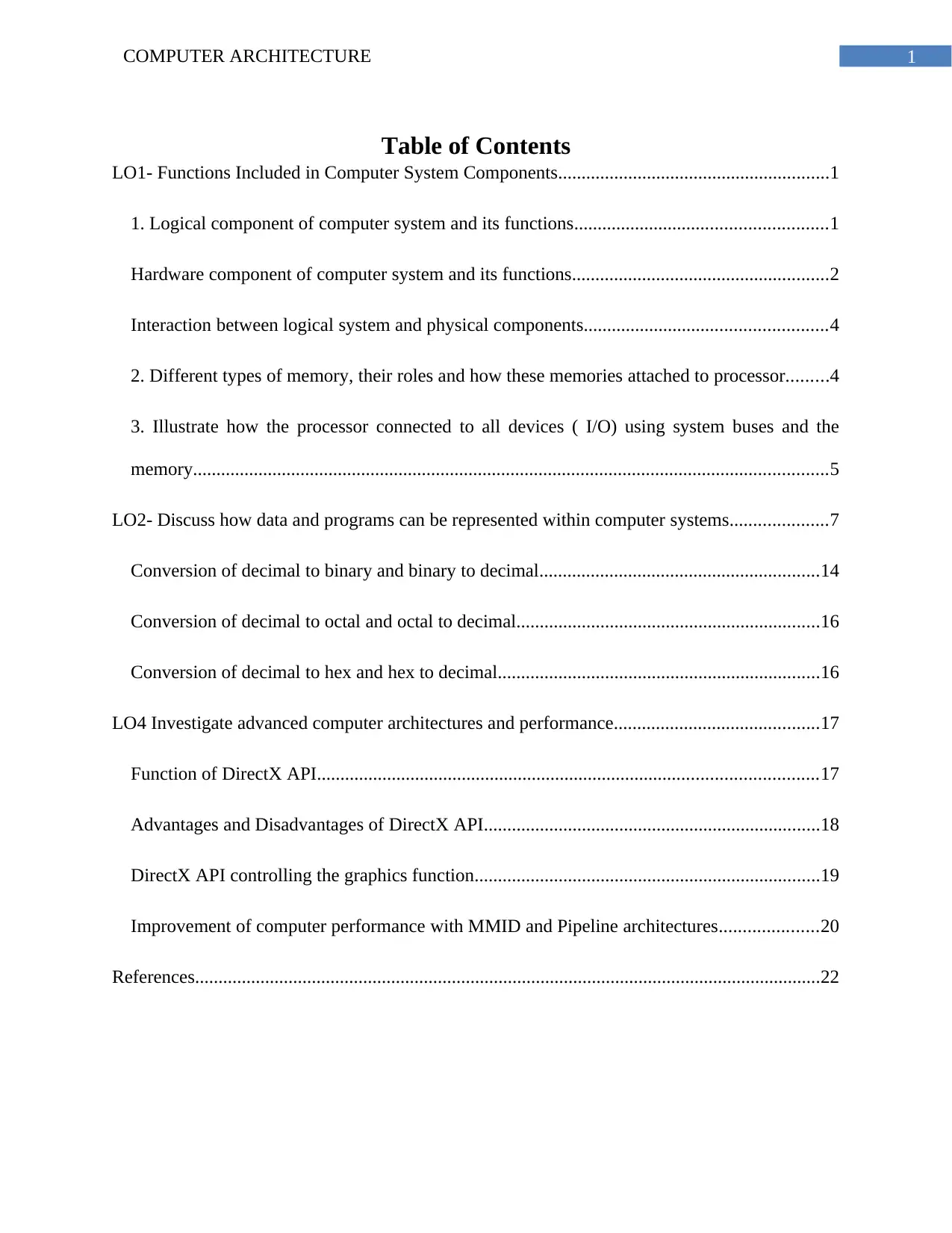
1COMPUTER ARCHITECTURE
Table of Contents
LO1- Functions Included in Computer System Components..........................................................1
1. Logical component of computer system and its functions......................................................1
Hardware component of computer system and its functions.......................................................2
Interaction between logical system and physical components....................................................4
2. Different types of memory, their roles and how these memories attached to processor.........4
3. Illustrate how the processor connected to all devices ( I/O) using system buses and the
memory........................................................................................................................................5
LO2- Discuss how data and programs can be represented within computer systems.....................7
Conversion of decimal to binary and binary to decimal............................................................14
Conversion of decimal to octal and octal to decimal.................................................................16
Conversion of decimal to hex and hex to decimal.....................................................................16
LO4 Investigate advanced computer architectures and performance............................................17
Function of DirectX API...........................................................................................................17
Advantages and Disadvantages of DirectX API........................................................................18
DirectX API controlling the graphics function..........................................................................19
Improvement of computer performance with MMID and Pipeline architectures.....................20
References......................................................................................................................................22
Table of Contents
LO1- Functions Included in Computer System Components..........................................................1
1. Logical component of computer system and its functions......................................................1
Hardware component of computer system and its functions.......................................................2
Interaction between logical system and physical components....................................................4
2. Different types of memory, their roles and how these memories attached to processor.........4
3. Illustrate how the processor connected to all devices ( I/O) using system buses and the
memory........................................................................................................................................5
LO2- Discuss how data and programs can be represented within computer systems.....................7
Conversion of decimal to binary and binary to decimal............................................................14
Conversion of decimal to octal and octal to decimal.................................................................16
Conversion of decimal to hex and hex to decimal.....................................................................16
LO4 Investigate advanced computer architectures and performance............................................17
Function of DirectX API...........................................................................................................17
Advantages and Disadvantages of DirectX API........................................................................18
DirectX API controlling the graphics function..........................................................................19
Improvement of computer performance with MMID and Pipeline architectures.....................20
References......................................................................................................................................22
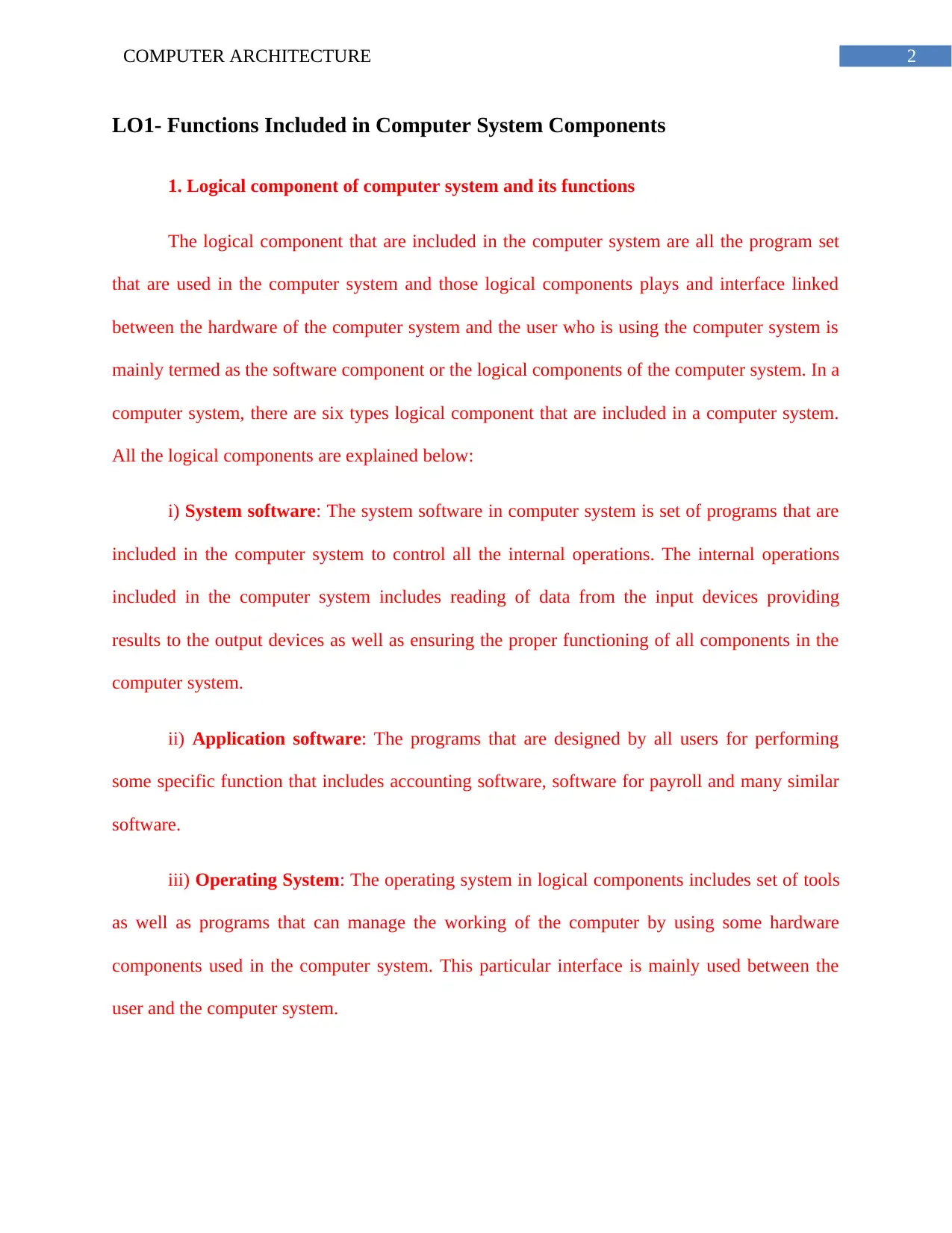
2COMPUTER ARCHITECTURE
LO1- Functions Included in Computer System Components
1. Logical component of computer system and its functions
The logical component that are included in the computer system are all the program set
that are used in the computer system and those logical components plays and interface linked
between the hardware of the computer system and the user who is using the computer system is
mainly termed as the software component or the logical components of the computer system. In a
computer system, there are six types logical component that are included in a computer system.
All the logical components are explained below:
i) System software: The system software in computer system is set of programs that are
included in the computer system to control all the internal operations. The internal operations
included in the computer system includes reading of data from the input devices providing
results to the output devices as well as ensuring the proper functioning of all components in the
computer system.
ii) Application software: The programs that are designed by all users for performing
some specific function that includes accounting software, software for payroll and many similar
software.
iii) Operating System: The operating system in logical components includes set of tools
as well as programs that can manage the working of the computer by using some hardware
components used in the computer system. This particular interface is mainly used between the
user and the computer system.
LO1- Functions Included in Computer System Components
1. Logical component of computer system and its functions
The logical component that are included in the computer system are all the program set
that are used in the computer system and those logical components plays and interface linked
between the hardware of the computer system and the user who is using the computer system is
mainly termed as the software component or the logical components of the computer system. In a
computer system, there are six types logical component that are included in a computer system.
All the logical components are explained below:
i) System software: The system software in computer system is set of programs that are
included in the computer system to control all the internal operations. The internal operations
included in the computer system includes reading of data from the input devices providing
results to the output devices as well as ensuring the proper functioning of all components in the
computer system.
ii) Application software: The programs that are designed by all users for performing
some specific function that includes accounting software, software for payroll and many similar
software.
iii) Operating System: The operating system in logical components includes set of tools
as well as programs that can manage the working of the computer by using some hardware
components used in the computer system. This particular interface is mainly used between the
user and the computer system.
⊘ This is a preview!⊘
Do you want full access?
Subscribe today to unlock all pages.

Trusted by 1+ million students worldwide
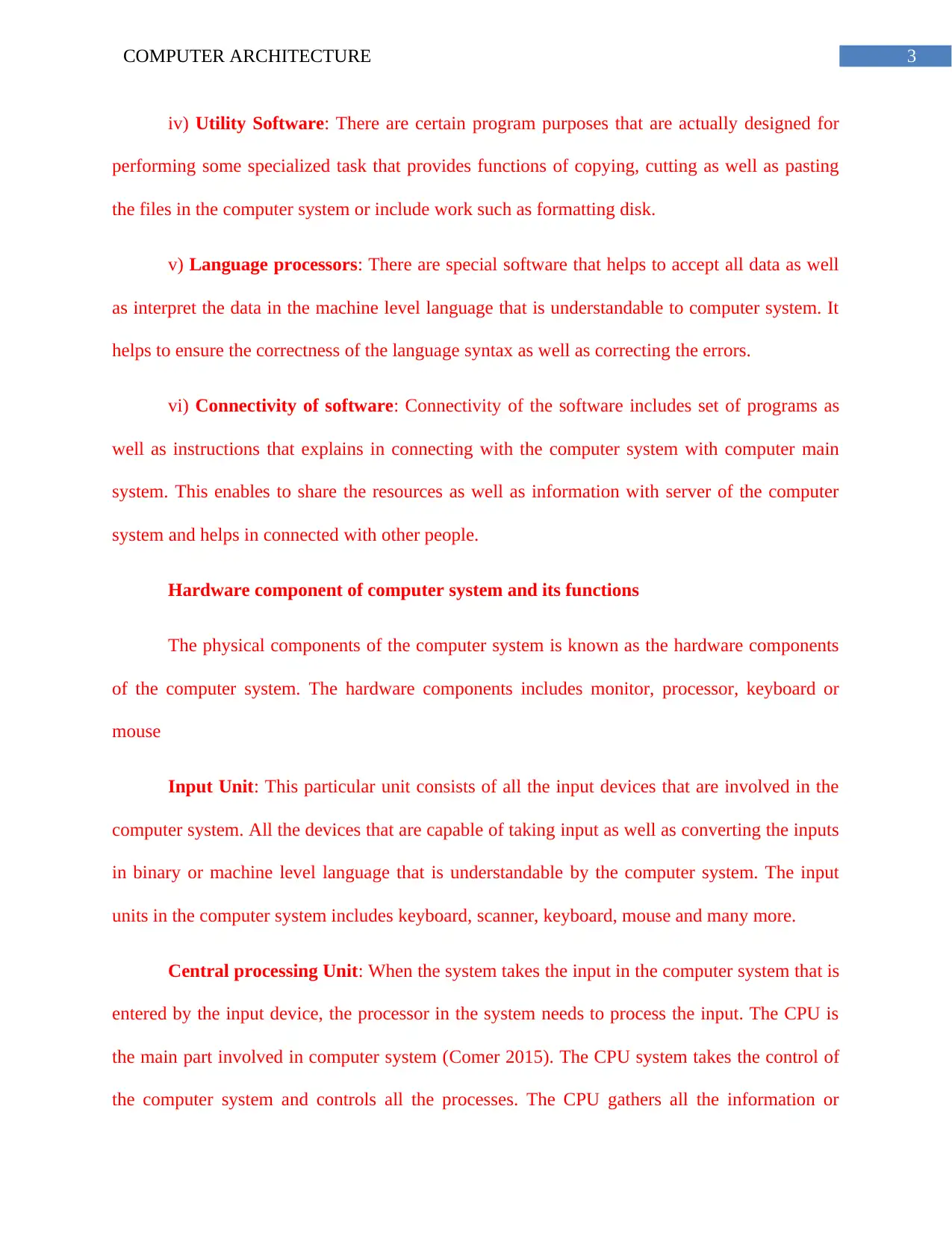
3COMPUTER ARCHITECTURE
iv) Utility Software: There are certain program purposes that are actually designed for
performing some specialized task that provides functions of copying, cutting as well as pasting
the files in the computer system or include work such as formatting disk.
v) Language processors: There are special software that helps to accept all data as well
as interpret the data in the machine level language that is understandable to computer system. It
helps to ensure the correctness of the language syntax as well as correcting the errors.
vi) Connectivity of software: Connectivity of the software includes set of programs as
well as instructions that explains in connecting with the computer system with computer main
system. This enables to share the resources as well as information with server of the computer
system and helps in connected with other people.
Hardware component of computer system and its functions
The physical components of the computer system is known as the hardware components
of the computer system. The hardware components includes monitor, processor, keyboard or
mouse
Input Unit: This particular unit consists of all the input devices that are involved in the
computer system. All the devices that are capable of taking input as well as converting the inputs
in binary or machine level language that is understandable by the computer system. The input
units in the computer system includes keyboard, scanner, keyboard, mouse and many more.
Central processing Unit: When the system takes the input in the computer system that is
entered by the input device, the processor in the system needs to process the input. The CPU is
the main part involved in computer system (Comer 2015). The CPU system takes the control of
the computer system and controls all the processes. The CPU gathers all the information or
iv) Utility Software: There are certain program purposes that are actually designed for
performing some specialized task that provides functions of copying, cutting as well as pasting
the files in the computer system or include work such as formatting disk.
v) Language processors: There are special software that helps to accept all data as well
as interpret the data in the machine level language that is understandable to computer system. It
helps to ensure the correctness of the language syntax as well as correcting the errors.
vi) Connectivity of software: Connectivity of the software includes set of programs as
well as instructions that explains in connecting with the computer system with computer main
system. This enables to share the resources as well as information with server of the computer
system and helps in connected with other people.
Hardware component of computer system and its functions
The physical components of the computer system is known as the hardware components
of the computer system. The hardware components includes monitor, processor, keyboard or
mouse
Input Unit: This particular unit consists of all the input devices that are involved in the
computer system. All the devices that are capable of taking input as well as converting the inputs
in binary or machine level language that is understandable by the computer system. The input
units in the computer system includes keyboard, scanner, keyboard, mouse and many more.
Central processing Unit: When the system takes the input in the computer system that is
entered by the input device, the processor in the system needs to process the input. The CPU is
the main part involved in computer system (Comer 2015). The CPU system takes the control of
the computer system and controls all the processes. The CPU gathers all the information or
Paraphrase This Document
Need a fresh take? Get an instant paraphrase of this document with our AI Paraphraser
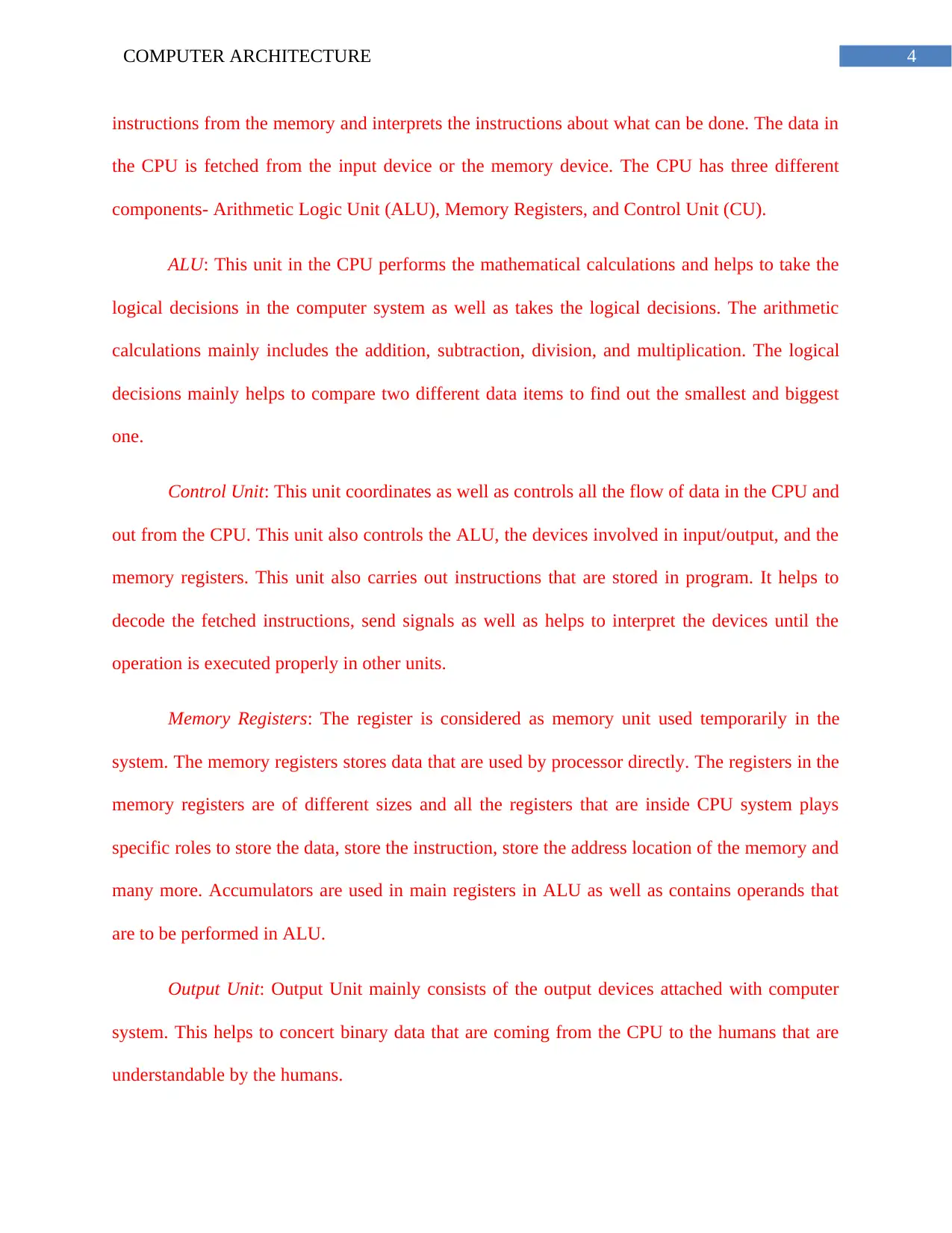
4COMPUTER ARCHITECTURE
instructions from the memory and interprets the instructions about what can be done. The data in
the CPU is fetched from the input device or the memory device. The CPU has three different
components- Arithmetic Logic Unit (ALU), Memory Registers, and Control Unit (CU).
ALU: This unit in the CPU performs the mathematical calculations and helps to take the
logical decisions in the computer system as well as takes the logical decisions. The arithmetic
calculations mainly includes the addition, subtraction, division, and multiplication. The logical
decisions mainly helps to compare two different data items to find out the smallest and biggest
one.
Control Unit: This unit coordinates as well as controls all the flow of data in the CPU and
out from the CPU. This unit also controls the ALU, the devices involved in input/output, and the
memory registers. This unit also carries out instructions that are stored in program. It helps to
decode the fetched instructions, send signals as well as helps to interpret the devices until the
operation is executed properly in other units.
Memory Registers: The register is considered as memory unit used temporarily in the
system. The memory registers stores data that are used by processor directly. The registers in the
memory registers are of different sizes and all the registers that are inside CPU system plays
specific roles to store the data, store the instruction, store the address location of the memory and
many more. Accumulators are used in main registers in ALU as well as contains operands that
are to be performed in ALU.
Output Unit: Output Unit mainly consists of the output devices attached with computer
system. This helps to concert binary data that are coming from the CPU to the humans that are
understandable by the humans.
instructions from the memory and interprets the instructions about what can be done. The data in
the CPU is fetched from the input device or the memory device. The CPU has three different
components- Arithmetic Logic Unit (ALU), Memory Registers, and Control Unit (CU).
ALU: This unit in the CPU performs the mathematical calculations and helps to take the
logical decisions in the computer system as well as takes the logical decisions. The arithmetic
calculations mainly includes the addition, subtraction, division, and multiplication. The logical
decisions mainly helps to compare two different data items to find out the smallest and biggest
one.
Control Unit: This unit coordinates as well as controls all the flow of data in the CPU and
out from the CPU. This unit also controls the ALU, the devices involved in input/output, and the
memory registers. This unit also carries out instructions that are stored in program. It helps to
decode the fetched instructions, send signals as well as helps to interpret the devices until the
operation is executed properly in other units.
Memory Registers: The register is considered as memory unit used temporarily in the
system. The memory registers stores data that are used by processor directly. The registers in the
memory registers are of different sizes and all the registers that are inside CPU system plays
specific roles to store the data, store the instruction, store the address location of the memory and
many more. Accumulators are used in main registers in ALU as well as contains operands that
are to be performed in ALU.
Output Unit: Output Unit mainly consists of the output devices attached with computer
system. This helps to concert binary data that are coming from the CPU to the humans that are
understandable by the humans.
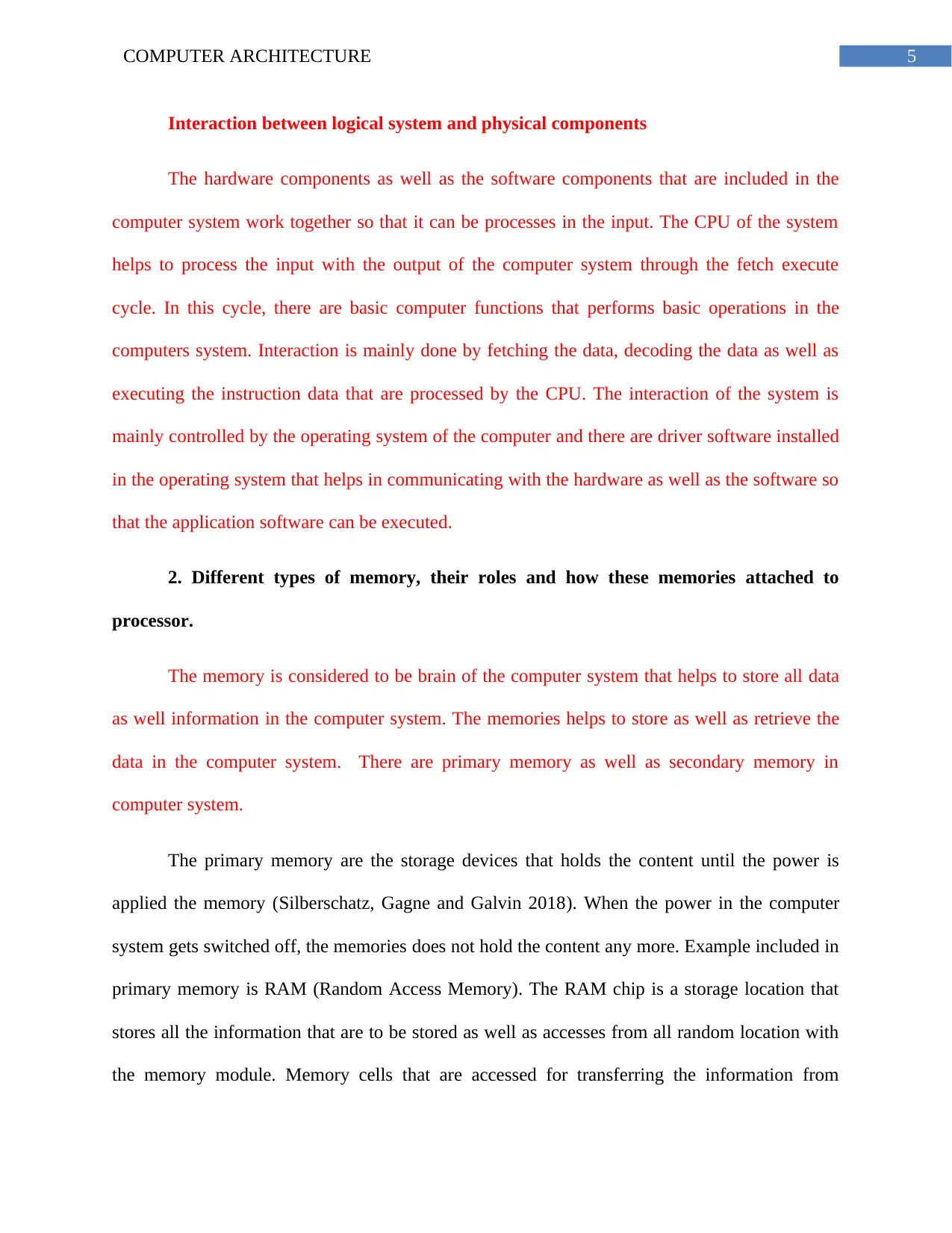
5COMPUTER ARCHITECTURE
Interaction between logical system and physical components
The hardware components as well as the software components that are included in the
computer system work together so that it can be processes in the input. The CPU of the system
helps to process the input with the output of the computer system through the fetch execute
cycle. In this cycle, there are basic computer functions that performs basic operations in the
computers system. Interaction is mainly done by fetching the data, decoding the data as well as
executing the instruction data that are processed by the CPU. The interaction of the system is
mainly controlled by the operating system of the computer and there are driver software installed
in the operating system that helps in communicating with the hardware as well as the software so
that the application software can be executed.
2. Different types of memory, their roles and how these memories attached to
processor.
The memory is considered to be brain of the computer system that helps to store all data
as well information in the computer system. The memories helps to store as well as retrieve the
data in the computer system. There are primary memory as well as secondary memory in
computer system.
The primary memory are the storage devices that holds the content until the power is
applied the memory (Silberschatz, Gagne and Galvin 2018). When the power in the computer
system gets switched off, the memories does not hold the content any more. Example included in
primary memory is RAM (Random Access Memory). The RAM chip is a storage location that
stores all the information that are to be stored as well as accesses from all random location with
the memory module. Memory cells that are accessed for transferring the information from
Interaction between logical system and physical components
The hardware components as well as the software components that are included in the
computer system work together so that it can be processes in the input. The CPU of the system
helps to process the input with the output of the computer system through the fetch execute
cycle. In this cycle, there are basic computer functions that performs basic operations in the
computers system. Interaction is mainly done by fetching the data, decoding the data as well as
executing the instruction data that are processed by the CPU. The interaction of the system is
mainly controlled by the operating system of the computer and there are driver software installed
in the operating system that helps in communicating with the hardware as well as the software so
that the application software can be executed.
2. Different types of memory, their roles and how these memories attached to
processor.
The memory is considered to be brain of the computer system that helps to store all data
as well information in the computer system. The memories helps to store as well as retrieve the
data in the computer system. There are primary memory as well as secondary memory in
computer system.
The primary memory are the storage devices that holds the content until the power is
applied the memory (Silberschatz, Gagne and Galvin 2018). When the power in the computer
system gets switched off, the memories does not hold the content any more. Example included in
primary memory is RAM (Random Access Memory). The RAM chip is a storage location that
stores all the information that are to be stored as well as accesses from all random location with
the memory module. Memory cells that are accessed for transferring the information from
⊘ This is a preview!⊘
Do you want full access?
Subscribe today to unlock all pages.

Trusted by 1+ million students worldwide
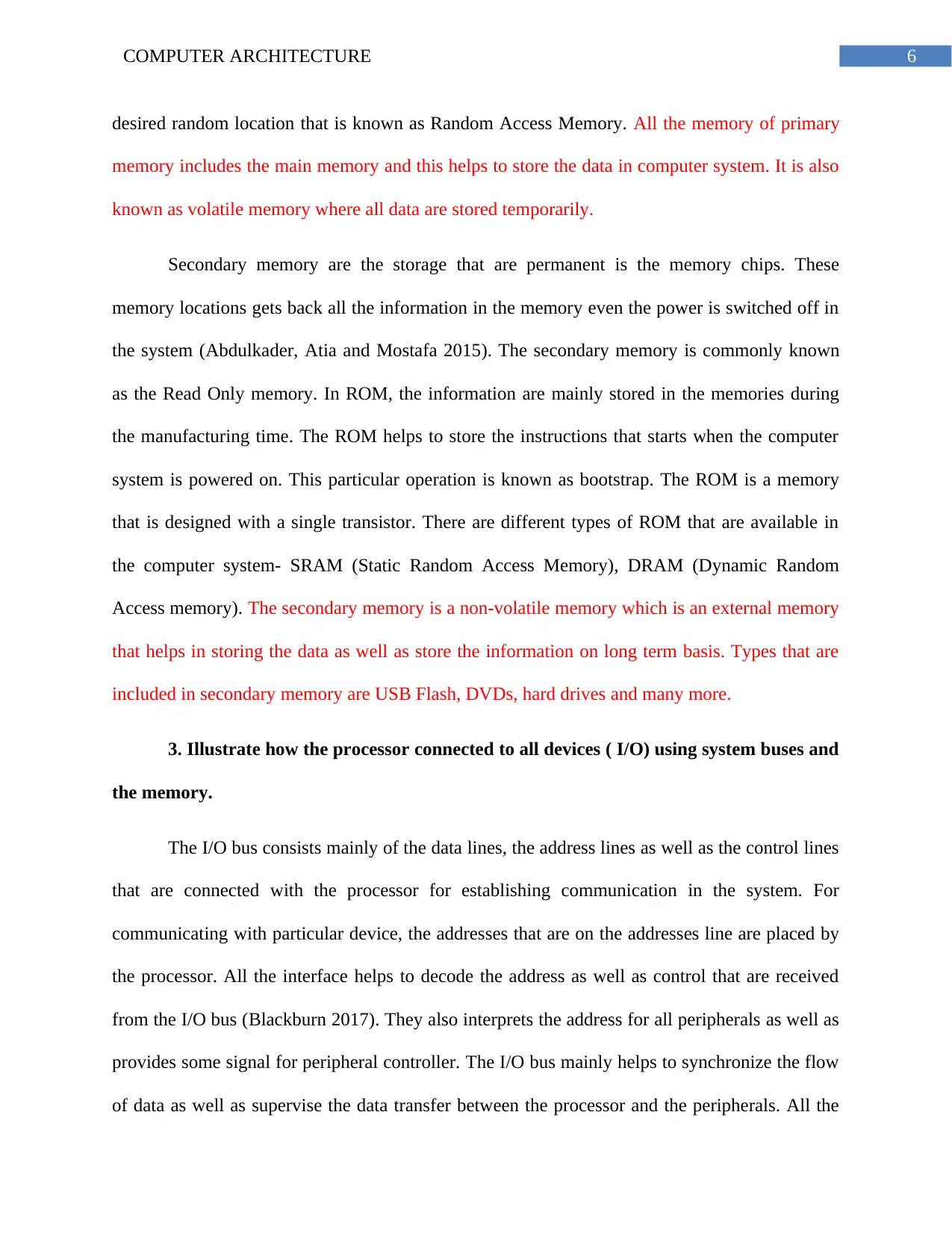
6COMPUTER ARCHITECTURE
desired random location that is known as Random Access Memory. All the memory of primary
memory includes the main memory and this helps to store the data in computer system. It is also
known as volatile memory where all data are stored temporarily.
Secondary memory are the storage that are permanent is the memory chips. These
memory locations gets back all the information in the memory even the power is switched off in
the system (Abdulkader, Atia and Mostafa 2015). The secondary memory is commonly known
as the Read Only memory. In ROM, the information are mainly stored in the memories during
the manufacturing time. The ROM helps to store the instructions that starts when the computer
system is powered on. This particular operation is known as bootstrap. The ROM is a memory
that is designed with a single transistor. There are different types of ROM that are available in
the computer system- SRAM (Static Random Access Memory), DRAM (Dynamic Random
Access memory). The secondary memory is a non-volatile memory which is an external memory
that helps in storing the data as well as store the information on long term basis. Types that are
included in secondary memory are USB Flash, DVDs, hard drives and many more.
3. Illustrate how the processor connected to all devices ( I/O) using system buses and
the memory.
The I/O bus consists mainly of the data lines, the address lines as well as the control lines
that are connected with the processor for establishing communication in the system. For
communicating with particular device, the addresses that are on the addresses line are placed by
the processor. All the interface helps to decode the address as well as control that are received
from the I/O bus (Blackburn 2017). They also interprets the address for all peripherals as well as
provides some signal for peripheral controller. The I/O bus mainly helps to synchronize the flow
of data as well as supervise the data transfer between the processor and the peripherals. All the
desired random location that is known as Random Access Memory. All the memory of primary
memory includes the main memory and this helps to store the data in computer system. It is also
known as volatile memory where all data are stored temporarily.
Secondary memory are the storage that are permanent is the memory chips. These
memory locations gets back all the information in the memory even the power is switched off in
the system (Abdulkader, Atia and Mostafa 2015). The secondary memory is commonly known
as the Read Only memory. In ROM, the information are mainly stored in the memories during
the manufacturing time. The ROM helps to store the instructions that starts when the computer
system is powered on. This particular operation is known as bootstrap. The ROM is a memory
that is designed with a single transistor. There are different types of ROM that are available in
the computer system- SRAM (Static Random Access Memory), DRAM (Dynamic Random
Access memory). The secondary memory is a non-volatile memory which is an external memory
that helps in storing the data as well as store the information on long term basis. Types that are
included in secondary memory are USB Flash, DVDs, hard drives and many more.
3. Illustrate how the processor connected to all devices ( I/O) using system buses and
the memory.
The I/O bus consists mainly of the data lines, the address lines as well as the control lines
that are connected with the processor for establishing communication in the system. For
communicating with particular device, the addresses that are on the addresses line are placed by
the processor. All the interface helps to decode the address as well as control that are received
from the I/O bus (Blackburn 2017). They also interprets the address for all peripherals as well as
provides some signal for peripheral controller. The I/O bus mainly helps to synchronize the flow
of data as well as supervise the data transfer between the processor and the peripherals. All the
Paraphrase This Document
Need a fresh take? Get an instant paraphrase of this document with our AI Paraphraser

7COMPUTER ARCHITECTURE
peripherals includes a controller. The printer controller mainly helps to control paper motion, and
printing timing. Control lines that are included in the I/O device is referred as the I/O command.
There are three types of I/O commands.
Control Commands: This command is mainly issues for activating peripherals as well as
informing what is to be done.
Status Commands: The status command is mainly used for testing different conditions of
status in the interface as well as peripheral device.
Data Output Commands: These commands are mainly caused by interface for responding
the data transferring from the bus to one of the registers.
Data Input Commands: The commands included in data input works opposite to the data
output.
For communication with the I/O, all the processors has to communicate with the memory
unit (Schulte, McDougall and Melski 2016). Similarly as the I/O bus, the total memory bus in the
system contains all data, helps in addressing the data as well as r/w the control lines. There are
mainly three ways by which the computer buses helps in communicating with the memory and
I/O devices.
1. Using two different buses; one bus is used for memory and the other bus is used for
I/O.
2. Using only one bus for both memory as well as I/O, but they use separate control lines
for communicating.
3. Using only one bus for both communication having one common line for control.
peripherals includes a controller. The printer controller mainly helps to control paper motion, and
printing timing. Control lines that are included in the I/O device is referred as the I/O command.
There are three types of I/O commands.
Control Commands: This command is mainly issues for activating peripherals as well as
informing what is to be done.
Status Commands: The status command is mainly used for testing different conditions of
status in the interface as well as peripheral device.
Data Output Commands: These commands are mainly caused by interface for responding
the data transferring from the bus to one of the registers.
Data Input Commands: The commands included in data input works opposite to the data
output.
For communication with the I/O, all the processors has to communicate with the memory
unit (Schulte, McDougall and Melski 2016). Similarly as the I/O bus, the total memory bus in the
system contains all data, helps in addressing the data as well as r/w the control lines. There are
mainly three ways by which the computer buses helps in communicating with the memory and
I/O devices.
1. Using two different buses; one bus is used for memory and the other bus is used for
I/O.
2. Using only one bus for both memory as well as I/O, but they use separate control lines
for communicating.
3. Using only one bus for both communication having one common line for control.

8COMPUTER ARCHITECTURE
The I/O processor, the computer includes independent data sets, address buses, as well as
control buses that helps in to access the memory and all other I/O device. This is mainly done on
the computers that helps to provide some different I/O processor. The purpose included in IOP is
basically provided as independent pathway for transferring the information between internal
memory as well as in external memory.
LO2- Discuss how data and programs can be represented within computer
systems
Data Representation:
The computer systems mainly uses binary digits from 0 to 1 for storing the data. Binary
digit is considered as smallest data unit for data computing. The binary digit is generally
represented by 0 and 1. The circuits in the computer system or the processor are generally made
up of millions of transistors (Hwang and Jotwani 2016). This is a small switch that gets activated
by some electronic signal that is received by the transistor. The binary digital system 0 and 1
mainly reflects two different states, on state and off state. The computer programs generally
provides program including instruction sets. All the instruction sets are basically converted to
machine code that are converted to simple binary codes that activates the CPU. All the
programmers who writes the computer code writes the codes in human language and language is
then converted to binary documents that are executed by processors.
Different types of data in computer system:
There are different data types in the computer system. The data type is mainly classified
in computer system that mainly states variable as well as object that can hold in the computer
programming. The types of data that has become very important factor is used in computer
The I/O processor, the computer includes independent data sets, address buses, as well as
control buses that helps in to access the memory and all other I/O device. This is mainly done on
the computers that helps to provide some different I/O processor. The purpose included in IOP is
basically provided as independent pathway for transferring the information between internal
memory as well as in external memory.
LO2- Discuss how data and programs can be represented within computer
systems
Data Representation:
The computer systems mainly uses binary digits from 0 to 1 for storing the data. Binary
digit is considered as smallest data unit for data computing. The binary digit is generally
represented by 0 and 1. The circuits in the computer system or the processor are generally made
up of millions of transistors (Hwang and Jotwani 2016). This is a small switch that gets activated
by some electronic signal that is received by the transistor. The binary digital system 0 and 1
mainly reflects two different states, on state and off state. The computer programs generally
provides program including instruction sets. All the instruction sets are basically converted to
machine code that are converted to simple binary codes that activates the CPU. All the
programmers who writes the computer code writes the codes in human language and language is
then converted to binary documents that are executed by processors.
Different types of data in computer system:
There are different data types in the computer system. The data type is mainly classified
in computer system that mainly states variable as well as object that can hold in the computer
programming. The types of data that has become very important factor is used in computer
⊘ This is a preview!⊘
Do you want full access?
Subscribe today to unlock all pages.

Trusted by 1+ million students worldwide
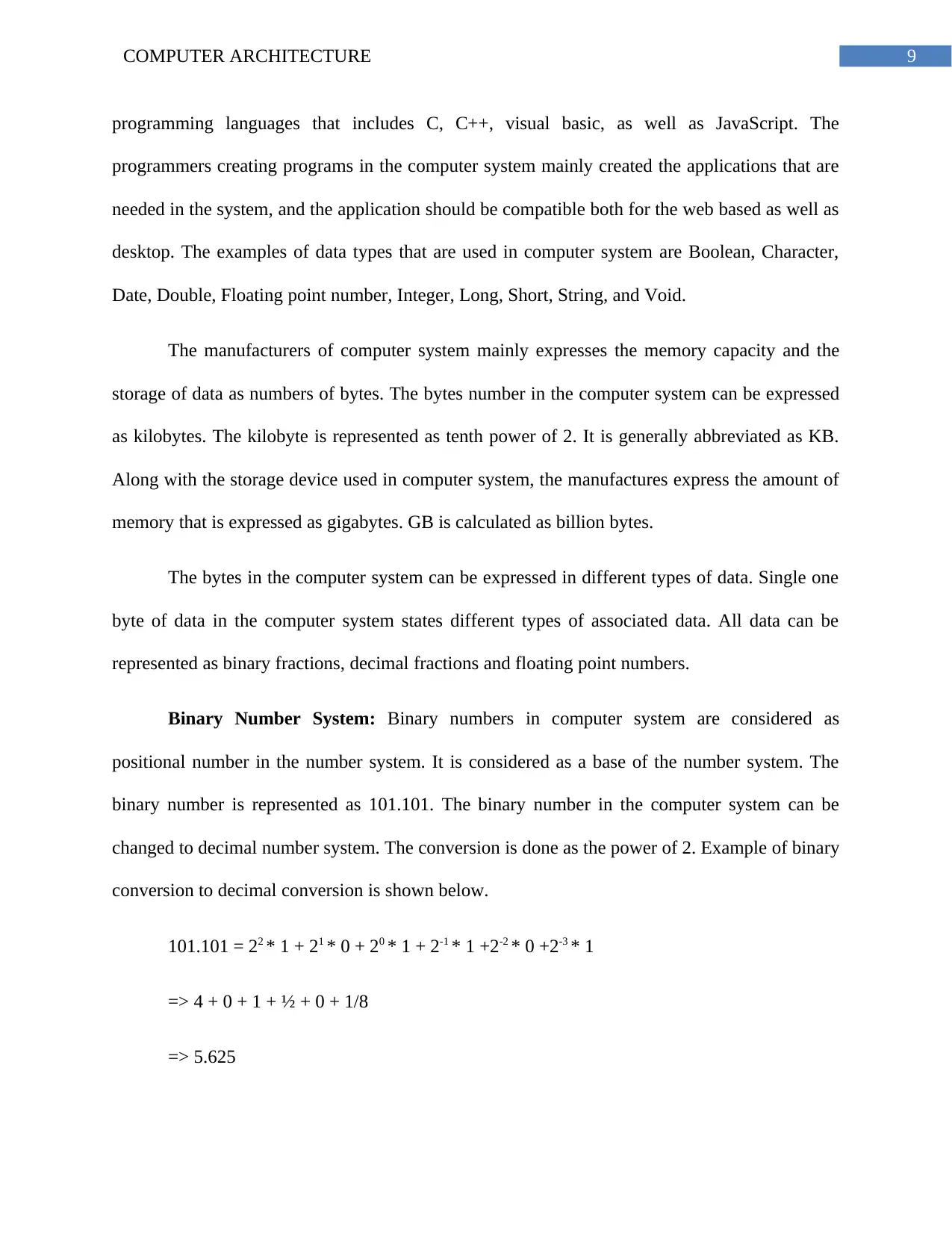
9COMPUTER ARCHITECTURE
programming languages that includes C, C++, visual basic, as well as JavaScript. The
programmers creating programs in the computer system mainly created the applications that are
needed in the system, and the application should be compatible both for the web based as well as
desktop. The examples of data types that are used in computer system are Boolean, Character,
Date, Double, Floating point number, Integer, Long, Short, String, and Void.
The manufacturers of computer system mainly expresses the memory capacity and the
storage of data as numbers of bytes. The bytes number in the computer system can be expressed
as kilobytes. The kilobyte is represented as tenth power of 2. It is generally abbreviated as KB.
Along with the storage device used in computer system, the manufactures express the amount of
memory that is expressed as gigabytes. GB is calculated as billion bytes.
The bytes in the computer system can be expressed in different types of data. Single one
byte of data in the computer system states different types of associated data. All data can be
represented as binary fractions, decimal fractions and floating point numbers.
Binary Number System: Binary numbers in computer system are considered as
positional number in the number system. It is considered as a base of the number system. The
binary number is represented as 101.101. The binary number in the computer system can be
changed to decimal number system. The conversion is done as the power of 2. Example of binary
conversion to decimal conversion is shown below.
101.101 = 22 * 1 + 21 * 0 + 20 * 1 + 2-1 * 1 +2-2 * 0 +2-3 * 1
=> 4 + 0 + 1 + ½ + 0 + 1/8
=> 5.625
programming languages that includes C, C++, visual basic, as well as JavaScript. The
programmers creating programs in the computer system mainly created the applications that are
needed in the system, and the application should be compatible both for the web based as well as
desktop. The examples of data types that are used in computer system are Boolean, Character,
Date, Double, Floating point number, Integer, Long, Short, String, and Void.
The manufacturers of computer system mainly expresses the memory capacity and the
storage of data as numbers of bytes. The bytes number in the computer system can be expressed
as kilobytes. The kilobyte is represented as tenth power of 2. It is generally abbreviated as KB.
Along with the storage device used in computer system, the manufactures express the amount of
memory that is expressed as gigabytes. GB is calculated as billion bytes.
The bytes in the computer system can be expressed in different types of data. Single one
byte of data in the computer system states different types of associated data. All data can be
represented as binary fractions, decimal fractions and floating point numbers.
Binary Number System: Binary numbers in computer system are considered as
positional number in the number system. It is considered as a base of the number system. The
binary number is represented as 101.101. The binary number in the computer system can be
changed to decimal number system. The conversion is done as the power of 2. Example of binary
conversion to decimal conversion is shown below.
101.101 = 22 * 1 + 21 * 0 + 20 * 1 + 2-1 * 1 +2-2 * 0 +2-3 * 1
=> 4 + 0 + 1 + ½ + 0 + 1/8
=> 5.625
Paraphrase This Document
Need a fresh take? Get an instant paraphrase of this document with our AI Paraphraser
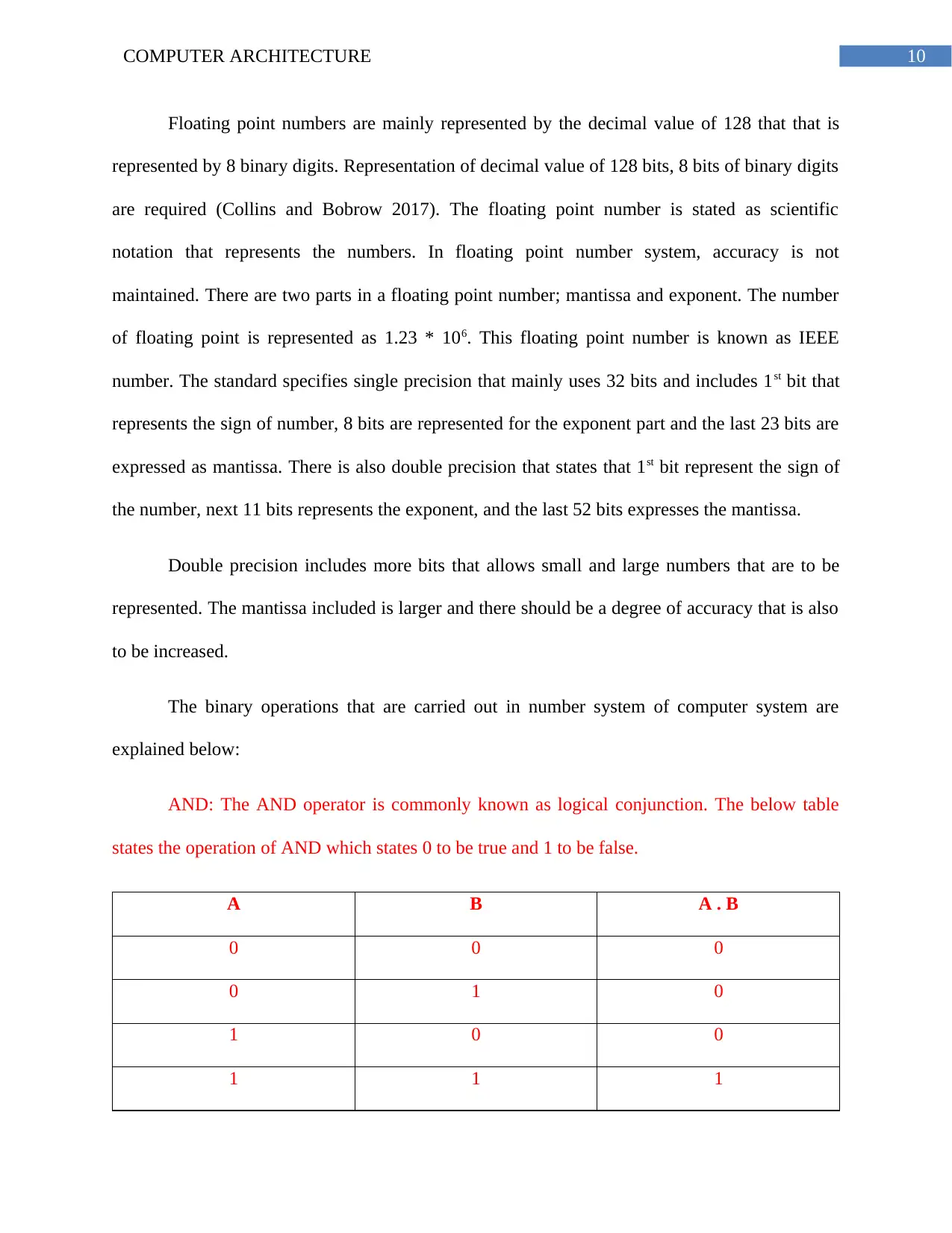
10COMPUTER ARCHITECTURE
Floating point numbers are mainly represented by the decimal value of 128 that that is
represented by 8 binary digits. Representation of decimal value of 128 bits, 8 bits of binary digits
are required (Collins and Bobrow 2017). The floating point number is stated as scientific
notation that represents the numbers. In floating point number system, accuracy is not
maintained. There are two parts in a floating point number; mantissa and exponent. The number
of floating point is represented as 1.23 * 106. This floating point number is known as IEEE
number. The standard specifies single precision that mainly uses 32 bits and includes 1st bit that
represents the sign of number, 8 bits are represented for the exponent part and the last 23 bits are
expressed as mantissa. There is also double precision that states that 1st bit represent the sign of
the number, next 11 bits represents the exponent, and the last 52 bits expresses the mantissa.
Double precision includes more bits that allows small and large numbers that are to be
represented. The mantissa included is larger and there should be a degree of accuracy that is also
to be increased.
The binary operations that are carried out in number system of computer system are
explained below:
AND: The AND operator is commonly known as logical conjunction. The below table
states the operation of AND which states 0 to be true and 1 to be false.
A B A . B
0 0 0
0 1 0
1 0 0
1 1 1
Floating point numbers are mainly represented by the decimal value of 128 that that is
represented by 8 binary digits. Representation of decimal value of 128 bits, 8 bits of binary digits
are required (Collins and Bobrow 2017). The floating point number is stated as scientific
notation that represents the numbers. In floating point number system, accuracy is not
maintained. There are two parts in a floating point number; mantissa and exponent. The number
of floating point is represented as 1.23 * 106. This floating point number is known as IEEE
number. The standard specifies single precision that mainly uses 32 bits and includes 1st bit that
represents the sign of number, 8 bits are represented for the exponent part and the last 23 bits are
expressed as mantissa. There is also double precision that states that 1st bit represent the sign of
the number, next 11 bits represents the exponent, and the last 52 bits expresses the mantissa.
Double precision includes more bits that allows small and large numbers that are to be
represented. The mantissa included is larger and there should be a degree of accuracy that is also
to be increased.
The binary operations that are carried out in number system of computer system are
explained below:
AND: The AND operator is commonly known as logical conjunction. The below table
states the operation of AND which states 0 to be true and 1 to be false.
A B A . B
0 0 0
0 1 0
1 0 0
1 1 1

11COMPUTER ARCHITECTURE
OR Operation: The truth table of the OR operation is shown below
A B A + B
0 0 0
0 1 1
1 0 1
1 1 1
NOT Operation:
A A
0 1
1 0
There are logic gates that are considered as an elementary block in the digital circuit
diagram. The logic gates takes two input and includes one output (Uhlmann 2018). The terminals
in the digital circuit includes two binary conditions that is high as well as low and those are
represented as voltage levels. There is AND gate, OR gate, NOT gate, NOR gate, NAND gate,
and XNOR gate that are included in logic gates.
Adder in digital logic gates mainly implements addition of the numbers. Address are used
in many processors for calculating the addresses, they are also used for doing similar operations
as well as includes table indices in ALU and includes other parts of the processors. There is half
Adder and full adder that are used in digital circuits. The Half adder helps in adding two binary
OR Operation: The truth table of the OR operation is shown below
A B A + B
0 0 0
0 1 1
1 0 1
1 1 1
NOT Operation:
A A
0 1
1 0
There are logic gates that are considered as an elementary block in the digital circuit
diagram. The logic gates takes two input and includes one output (Uhlmann 2018). The terminals
in the digital circuit includes two binary conditions that is high as well as low and those are
represented as voltage levels. There is AND gate, OR gate, NOT gate, NOR gate, NAND gate,
and XNOR gate that are included in logic gates.
Adder in digital logic gates mainly implements addition of the numbers. Address are used
in many processors for calculating the addresses, they are also used for doing similar operations
as well as includes table indices in ALU and includes other parts of the processors. There is half
Adder and full adder that are used in digital circuits. The Half adder helps in adding two binary
⊘ This is a preview!⊘
Do you want full access?
Subscribe today to unlock all pages.

Trusted by 1+ million students worldwide
1 out of 24
Related Documents
Your All-in-One AI-Powered Toolkit for Academic Success.
+13062052269
info@desklib.com
Available 24*7 on WhatsApp / Email
![[object Object]](/_next/static/media/star-bottom.7253800d.svg)
Unlock your academic potential
Copyright © 2020–2025 A2Z Services. All Rights Reserved. Developed and managed by ZUCOL.



